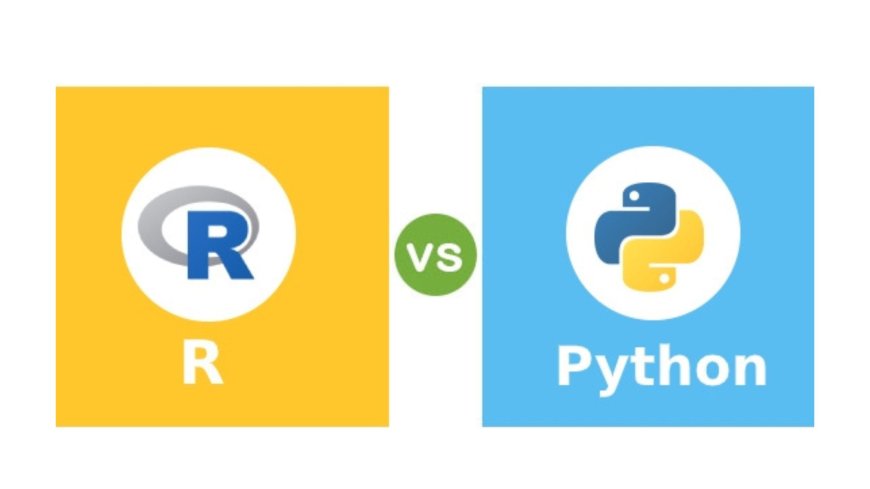Python vs R: A Comparison for Data Analysis
Explore Python, R, data analysis, comparison, statistics, visualization, tools, efficiency, code, libraries, and applications. Choose the right tool

Python and R have emerged as prominent contenders for data analysis. Python's adaptability and diverse libraries have made it a favored choice, spanning data analysis, web development, and AI. Meanwhile, R's specialized focus on statistics and tailored packages like dplyr and ggplot2 make it a stalwart for in-depth analysis. This comparison delves into their strengths, applications, and factors influencing the language choice. While Python finds widespread industry use, R maintains academic and statistical prominence. Deciding between them hinges on task nature, learning curves, libraries, and community support. This exploration empowers data professionals with insights for choosing the right language and capitalizing on evolving data trends.
Python for Data Analysis
Python, a versatile and dynamically-typed programming language, has gained immense popularity in the realm of data analysis. Known for its clean and readable syntax, Python has evolved from a general-purpose language into a robust platform for various data-centric tasks. Its open-source nature, extensive community support, and rich ecosystem of libraries have positioned Python as a frontrunner in the data analysis landscape.
Strengths of Python in Data Analysis
-
General-Purpose Programming Language
Python's status as a general-purpose language grants it the flexibility to extend beyond data analysis. This adaptability facilitates integration with other tasks, such as web development, scripting, automation, and scientific computing.
-
Rich Ecosystem of Libraries
Python's strength lies in its vast collection of libraries catering to diverse data analysis needs. Libraries like NumPy for numerical operations, pandas for data manipulation, Matplotlib for visualization, and scikit-learn for machine learning empower analysts to efficiently perform complex tasks.
-
Versatility for Tasks Beyond Data Analysis
Python's wide applicability transcends data analysis. It serves as a capable language for building web applications, conducting scientific research, developing natural language processing tools, and delving into artificial intelligence and deep learning.
Examples of Python's Applications in Data Analysis
-
Exploratory Data Analysis (EDA)
Python simplifies EDA through libraries like pandas and Matplotlib. Analysts can easily load, clean, visualize, and summarize datasets, uncovering patterns and trends that inform further analysis.
-
Machine Learning and Deep Learning
Python's popularity in machine learning is attributed to libraries like scikit-learn, TensorFlow, and PyTorch. These frameworks enable the development of intricate models for tasks like classification, regression, clustering, and neural networks.
-
Web Scraping and Data Collection
Python's libraries, such as Beautiful Soup and Requests, facilitate web scraping for data collection. This is vital for aggregating information from websites and online sources.
R for Data Analysis
R stands as a revered programming language in the field of data analysis, especially prized for its robust capabilities in statistical computing and visualization. Originating from academia and research, R's syntax is purpose-built to articulate intricate statistical operations, catering to tasks like hypothesis testing, linear and non-linear modeling, and survival analysis with exceptional clarity.
What truly distinguishes R is its extensive range of dedicated packages tailored explicitly for data analysis and statistical exploration. For instance, the dplyr package offers an intuitive grammar for data manipulation, enabling effortless tasks such as filtering, grouping, and summarizing data. Similarly, ggplot2 provides a potent framework for crafting sophisticated and visually compelling data representations, enhancing R's status as an indispensable environment for in-depth data analysis.
Strengths of R in Data Analysis
-
Wide Range of Packages and Libraries
R boasts an extensive collection of packages and libraries that cater to various data analysis tasks. These packages cover everything from data manipulation and visualization to statistical modeling and machine learning. The Comprehensive R Archive Network (CRAN) and other repositories host thousands of packages developed by the community, making it easy to find tools for specific data analysis needs.
-
Statistical Analysis and Visualization
R was initially designed by statisticians, which is reflected in its strong capabilities for statistical analysis. It offers a wide array of statistical functions and techniques, making it a go-to choice for researchers and data analysts. Moreover, R provides powerful data visualization libraries like ggplot2, lattice, and base graphics, allowing users to create visually appealing and informative plots to explore and present their data effectively.
-
Open Source and Active Community
R is an open-source language, meaning that it's freely available for anyone to use and contribute to. This has fostered a vibrant and active community of users and developers who continuously enhance the language's functionality. The open nature of R encourages collaboration, knowledge sharing, and the development of innovative tools for data analysis.
Examples of R Applications in Data Analysis
-
Data Cleaning and Preprocessing
R provides tools to clean and preprocess raw data before analysis, including handling missing values, removing outliers, and transforming data. Packages like dplyr and tidyr are commonly used for these tasks.
-
Exploratory Data Analysis (EDA)
R is excellent for creating visualizations and summary statistics to explore and understand datasets. The ggplot2 package is famous for creating complex and aesthetically pleasing graphs, while functions like summary() and describe() help generate basic statistics.
-
Statistical Analysis
R has an extensive set of built-in functions and packages for performing a wide range of statistical analyses. From basic t-tests and ANOVAs to advanced regression models and multivariate analyses, R can handle complex statistical computations.
Key Factors for Choosing Between Python and R
Selecting the right programming language for data analysis can significantly impact the efficiency and effectiveness of your projects. Both Python and R offer distinct advantages, and the decision hinges on several key factors tailored to your specific analysis goals and context.
-
Nature of Analysis Tasks
The nature of the tasks you intend to tackle plays a pivotal role in the language selection. If your analysis leans heavily toward statistical modeling, hypothesis testing, and data visualization, R's specialized packages like ggplot2 and dplyr make it a natural choice. On the other hand, if your work extends into machine learning, web development, or other general programming tasks alongside data analysis, Python's versatile libraries such as pandas, scikit-learn, and TensorFlow might better suit your needs.
-
Learning Curve and Ease of Use
Python's syntax is often lauded for its readability and ease of learning, making it an attractive option for newcomers to programming and data analysis. R, while optimized for expressing statistical concepts, can have a steeper learning curve, especially for those without a statistical background. Consider your team's familiarity with programming and the time available for upskilling when deciding on a language.
-
Ecosystem and Libraries
Python's vast ecosystem encompasses not only data analysis but also web development, automation, and more. This breadth provides a distinct advantage if you need to integrate data analysis into broader applications. R's strength lies in its specialized packages tailored for statistical tasks, offering a focused and comprehensive toolset. Evaluate the availability of packages for your specific analysis requirements in each language.
-
Community and Support
Both Python and R boast vibrant communities, but the nature of their support differs. Python's community spans multiple domains and industries, resulting in abundant resources, tutorials, and forums. R's community, while smaller, is deeply rooted in statistics and academia, offering robust support for intricate statistical problems. Depending on your context, consider the availability of guidance and expertise within each community.
-
Industry Trends and Job Market
Python's versatility has led to its widespread adoption across industries, making it a safe bet in terms of employability. Many job postings now list Python as a preferred or required skill. R retains its prominence in academia, research, and certain sectors that emphasize statistical analysis. Evaluate industry trends and job market demands to align your language choice with your career aspirations.
Future Trends and Considerations
The future of data analysis is marked by exciting shifts due to technological advances and industry changes, shaping the ongoing Python vs. R debate. A notable trend is the increasing convergence of Python and R capabilities, blending their strengths for versatile solutions. Initiatives like Python integration in R and using R within Jupyter notebooks showcase this trend. Hybrid approaches, merging Python's machine learning with R's statistical prowess, are on the rise, emphasizing flexibility.
Python remains dominant in fields needing broader software integration, web development, and AI due to its strong ecosystem and support. R retains its academic stronghold, excelling in precise statistical analysis and complex visualizations for disciplines like economics and social sciences.
The choice between Python and R now centers more on suitability than superiority. Tomorrow's data professionals will likely master multiple languages, adapting to evolving landscapes and selecting the best tool for each task. As the field evolves, flexibility will empower professionals to navigate innovation, integration, and the pursuit of valuable insights.
The choice between Python and R depends on the specific needs and context of the task at hand. Python offers a versatile and extensive ecosystem, making it an excellent choice for general-purpose programming, data analysis, machine learning, web development, and more. Its readability and popularity contribute to a larger community and abundant resources. On the other hand, R excels in statistical analysis and visualization, with dedicated packages tailored for data exploration and manipulation. Researchers and statisticians often prefer R for its domain-specific capabilities. Ultimately, the decision boils down to the nature of the project and the user's familiarity with each language. Many professionals find value in learning both Python and R, as this versatility allows them to tackle a wide range of tasks effectively.




































